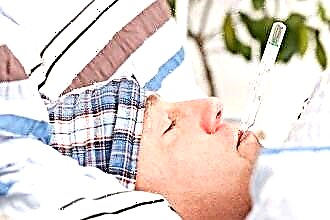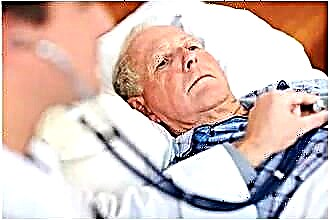There are situations when a child constantly coughs, as if he has a sore throat. What does this indicate? We all know that a sore throat in a child and an adult is one of the first signs of a cold. The common cold refers to a variety of viral and bacterial diseases. Some of them are deadly (such as flu, sore throat), while others usually go away easily and without consequences (for example, a rhinovirus infection that causes rhinopharyngitis).
A sore throat can be observed both against a background of normal temperature and with fever, and may or may not be accompanied by pain when swallowing. Also, perspiration is often accompanied by a runny nose or cough.
When making a diagnosis, all accompanying symptoms are taken into account, both local in nature (presence of plaque in the throat, swelling of the tonsils, etc.) and general (thermometry indicators, child's activity, his appetite).
 In any case, if a child has a sore throat, he needs the close attention of his parents. The patient should be examined, first of all, his throat. If you suspect pharyngitis or sore throat, it is recommended to consult a pediatrician or otolaryngologist.
In any case, if a child has a sore throat, he needs the close attention of his parents. The patient should be examined, first of all, his throat. If you suspect pharyngitis or sore throat, it is recommended to consult a pediatrician or otolaryngologist.
In this article, we will discuss the causes of a sore throat in children and talk about effective ways to treat a sore throat.
Sore throat reasons
It is customary to call a feeling of moderate pain, dryness and burning sensation in the throat. Such sensations are often the first messengers of respiratory diseases. So, perspiration can be observed in the early stages of the following diseases:
- flu;
- parainfluenza;
- respiratory syncytial infection;
- pharyngitis;
- laryngitis;
- tonsillitis (i.e. tonsillitis);
- mixed forms of acute respiratory infections (for example, rhinopharyngitis, pharyngolaryngitis, laryngotracheitis, etc.).
Depending on the disease, the patient develops other symptoms of the disease, for example, a runny nose (with rhinopharyngitis), hoarseness (with laryngitis), acute pain when swallowing (with angina).
It is inappropriate to judge the causes and localization of the disease on the basis of one symptom, namely sore throat. It is necessary to take into account other symptoms observed in the patient.
We suggest that you familiarize yourself with the table, which presents the main symptoms of colds in the human throat (table 1). Please note - the table cannot be used for diagnosis and treatment. The information presented helps to form an understanding of the variety of throat diseases and the variability of their clinical manifestations.
| Symptom | Tonsillitis (tonsillitis) | Pharyngitis | Laryngitis |
|---|---|---|---|
| Localization of infection | Pharyngeal tonsils (tonsils). | Pharyngeal mucosa. | Larynx; the infection affects the vocal cords. |
| Causes | The causative agents of infection are some ARVI viruses, as well as bacteria - streptococcus and staphylococcus (less often others). the likelihood of infection increases with hypothermia, decreased immunity, close contact with patients and carriers of the infection. | In most cases, the causative agent of the disease is respiratory viruses. the peak incidence is observed during the cold season. | Laryngitis can be caused by an infection (viral or bacterial), as well as physical strain on the vocal apparatus. in children, laryngitis can occur as a result of prolonged loud crying, screaming. |
| Sore throat | Sharp, constantly sore throat, difficult to swallow. | Moderate, may increase with swallowing. | Usually mild, it can be aggravated by talking, coughing. |
| Raids | Plaque covers the tonsils. depending on the type of tonsillitis: with catarrhal - slimy, transparent, with follicular - point, purulent, with lacunar - purulent in the form of spots. | Plaque is visible only on the visible part of the pharyngeal surface. usually it is mucopurulent, transparent and viscous. | There is no plaque in the throat (the larynx is below the visible part of the throat). |
| Hyperemia (swelling of the mucous membrane, redness) | The tonsils are usually greatly enlarged, red. the surface of the tonsils may be loose, unevenly swollen. | The back wall of the pharynx may be swollen, reddened. punctate hemorrhages are sometimes noticeable. often the soft palate also turns red. | Hyperemic changes are observed only if the infection affects the overlying respiratory organs (pharynx and oropharynx). |
| Patient's body temperature | Strongly increased from the first day of illness (above 38 ° C, in children it is often above 39 ° C). | High (38 ° C and above). in older children, the temperature may rise slightly. | Normal or moderately elevated (rarely reaches 38 ° C). |
| Other symptoms | Severe headache, facial flushing, restlessness, loss of appetite, swollen lymph nodes in the neck. tonsillitis caused by adenovirus infection is often accompanied by conjunctivitis. | In children, pharyngitis almost always proceeds simultaneously with rhinitis, i.e. runny nose due to the spread of infection. the child coughs, especially in the morning, as mucus builds up in the throat. | Voice change - hoarseness, hoarseness, sometimes - complete loss of voice. often the disease is accompanied by a cough, especially if the infection affects the trachea. |
How to relieve perspiration
Both pharmacy and home remedies will help get rid of a sore throat in a child. The success of treatment largely depends on the stage of the disease. So, perspiration, which has just begun to bother, can be relieved by drinking hot tea with honey and lemon. Already on the second or third day of illness, this method will be ineffective. In this case, you should turn to stronger means:
 Gargling. The simplest, most affordable and safest method of treatment. You can gargle with decoctions of medicinal plants, a solution of soda (1 teaspoon per glass of water), or just a weak saline solution (1 teaspoon per liter of water).
Gargling. The simplest, most affordable and safest method of treatment. You can gargle with decoctions of medicinal plants, a solution of soda (1 teaspoon per glass of water), or just a weak saline solution (1 teaspoon per liter of water).- Sucking lozenges and tablets. Children love this method of treatment, as modern preparations for resorption have a pleasant taste. Lozenges can help relieve pain and inflammation.
- Spray throat. It has an antiseptic, analgesic and anti-inflammatory effect.
- Steam inhalation. Reduces pain, facilitates the passage of mucus and plaque. Can be used if the child's body temperature is normal. This method is contraindicated for children under 3 years old.
If your child has a sore throat, you need to kill the infection right away before it spreads deep into the respiratory system. Timely started treatment will allow you to get rid of the disease in a short time and prevent complications.
Some throat ailments are not as easy to cure as it might seem at first glance. For example, in case of angina, local treatment is ineffective - antibiotics are required to destroy the infection, moreover, in a certain dosage and for a sufficient number of days. If home treatment does not bring positive results within 2-3 days, see your doctor.

 Gargling. The simplest, most affordable and safest method of treatment. You can gargle with decoctions of medicinal plants, a solution of soda (1 teaspoon per glass of water), or just a weak saline solution (1 teaspoon per liter of water).
Gargling. The simplest, most affordable and safest method of treatment. You can gargle with decoctions of medicinal plants, a solution of soda (1 teaspoon per glass of water), or just a weak saline solution (1 teaspoon per liter of water).

